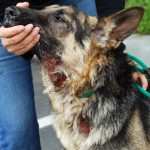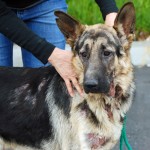TREATMENT OF DEMODEX OR DEMODECTIC MANGE
Since all dogs carry demodectic mites, we believe dogs who have problems are sufferinng from a compromised immune system. We do everything possible to build up their immune system, and let the dog’s body do the work of fighting off the mites. Avoid ALL poisonous dips and do not put ANYTHING toxic on your dog’s skin. Never resort to Mitaban for demodectic mange. Mitaban can be used with discretion for sarcoptic mange, but Revolution is the best treatment for sarcoptic mange and less toxic to your pet. Revolution has no effect on demodectic mange. If your dog is suffering from a skin infection secondary to the mites, she/he will need to be on antibiotics. Here’s what we do:
Bathing: You will need to bathe your dog every day to three times a week depending on the severity of the demodex/infection. Use a high quality shampoo such as Masaleb (www.omahavaccine.com or www.vetamerica.com) and let the shampoo sit on the dog’s coat for 10 minutes before rinsing. This will clear debris from the pores and help reduce the number of mites. As the condition of the dog improves, you can gradually bathe less and less, until the condition clears completely. Make very sure to have clean bedding (you can use old sheets to cover their beds).
Diet: It is extremely important that your dog be on a high quality diet which doesn’t include any wheat, corn or eggs. All are highly allergenic and can set up conditions perfect for mites. The dog’s diet shouldn’t contain any toxic preservatives, “animal digest” (which is all different parts of animals not used for people food – use your imagination) and the first ingredient should be high quality protien such as chicken or duck. Always check ingredients for toxic preservatives. If you don’t know what something is, look it up on the internet. Okay starches would be potato, barley or rice in that order. We have the best luck with Innova Evo, which is a dry dog food with no grain, just animal protien, plant and fruit, very close to a dog’s natural diet. Many people with demodex dogs choose to feed a raw diet which takes a bit of learning but is very helpful to these dogs. See information about feeding your dog in our FAQ section. Face it, you love your pet. You can’t feed it for a dollar a day and expect it to have a healthy and long life. For $2 a day you can have a longer living and healthier pet. Your choice. Don’t wait until your dog starts to experience health problems before you start thinking about its diet.
Supplements: Your dog should be supplemented with human grade zinc, ester C, and multiple B vitamins (just like you would buy for yourself) once a day. Also very important is supplementing your dog with Omega oils such as flax or salmon oil. We buy it in big sqeeze bottles at health food stores such as Henrys.
Exercise and Well Being: Your dog should be living in a clean environment. Dogs are pack animals and should be allowed to sleep in the house with their owners, otherwise you will have a stressed and anxious dog. You should be sure to play with your dog and take it for walks for, at the very least, a half an hour to an hour a day. Many dogs, especially young strong breeds, are built to hunt or herd for hours a day to earn their food and they only rest when they’ve done their job or achieved their goal. Us city dwellers must make up the difference for our pets. A tired dog is a happy and stress free dog. And as a bonus, most likely this happy dog will be living with a happier and healthier human family.
Ivermectin: As a last resort in dogs who can’t improve on their own, we give ORAL ivermectin. NO dips. This is injectible Ivomec (ivermectin) 1%cc, which we draw into a syringe, take the needle off of the syringe and put the evermec down the back of the dog’s throat (it tastes terrible!). A 70 pound dog should get 1cc once a day. This is less than vets recommends, but it works because its part of immunity building plan.
Skin Infection: If your dog has a skin infection secondary to demodex (called pyoderma), you will need to put it on a course of antibiotics. Depending on the dog’s condition you can begin with an antibiotic recommended by your vet. If your dog doesn’t respond, you can switch to a broader spectrum antibiotic, or if you can afford to have a culture done, that’s the best way to determine treatment. The culture will tell you which antibiotics will work best for your dog, and they should begin recovering right away. As the stress of the infection clears, her body is also getting better control of the mites.
Be aware that while most dogs will overcome demodex, some pets will need you to be alert to all these things over their entire lifetime. Most dogs will develop and immune system, with your help, that will beat the mites completely. Some dogs will need continuing care and strict attention from their owners to keep the condition in check.
If you’ve discovered a great way of dealing with demodex, we’d love to hear from you! And because skin conditions are of particular interest to us, please feel free to email us with any questions or comments about your experience with demodex. Email marcy@socalrescue.org.
Titan was turned in to SCGSR at nine months of age in January 2012. He had a deep, smelly skin infection from neglected demodex, so deep that he was bleeding through the t-shirt his owner brought him to us wearing. He had a ripped ear from being kenneled outside with two wolf hybrids, and a severe tapeworm infestation. Two weeks later he has beat his skin infection, been wormed, vaccinated, neutered, microchipped and had the rip in his ear repaired thanks to SCGSR supporters. Titan was treated with weekly hour-long 3 suds-up soaking baths, wormed with Drontil Plus, cephalexin anitibiotics, 1000 mgs two times a day, and was fed raw chicken only for the first week, along with fish oil caps as a supplement. That’s it.
Posted in: Health








